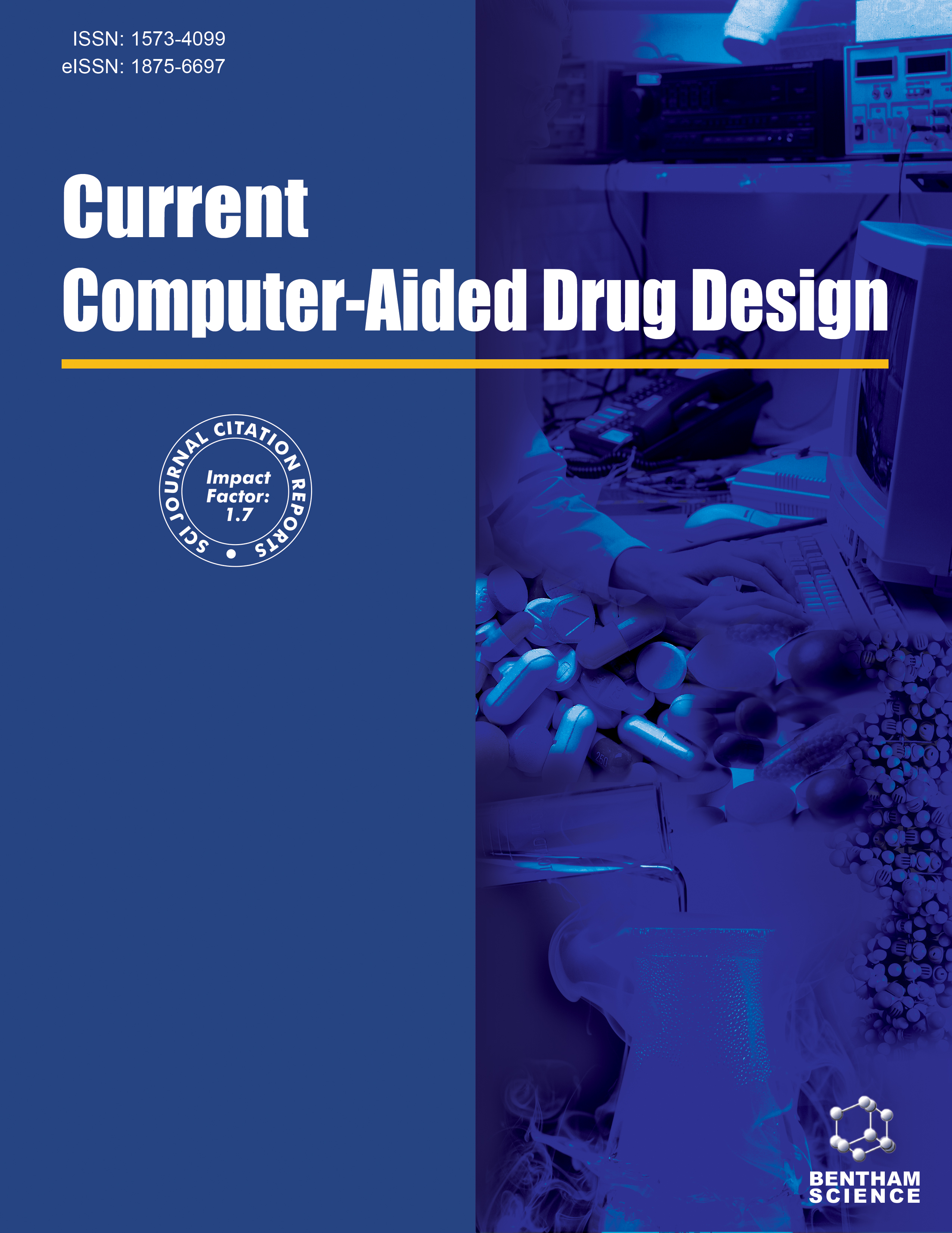- Home
- A-Z Publications
- Current Computer - Aided Drug Design
- Previous Issues
- Volume 11, Issue 4, 2015
Current Computer - Aided Drug Design - Volume 11, Issue 4, 2015
Volume 11, Issue 4, 2015
-
-
2D and 3D-QSAR analysis of pyrazole-thiazolinone derivatives as EGFR kinase inhibitors by CoMFA and CoMSIA
More LessTwo and Three-dimensional quantitative structure-activity relationship (2D, 3D-QSAR) study was performed for some pyrazole-thiazolinone derivatives as EGFR kinase inhibitors using the CoMFA, CoMSIA and GA-MLR methods. The utilized data set was split into training and test set based on hierarchical clustering technique. From the five CoMSIA descriptors, electrostatic field presented the highest correlation with the acti Read More
-
-
-
Water Molecules Increases Binding Affinity of Natural PI3Kγ Inhibitors Against Cancer
More LessAuthors: Pooja Sharma, Aparna Shukla, Komal Kalani, Vijaya Dubey, Santosh K. Srivastava, Suaib Luqman and Feroz KhanThe PI3K pathway is a signal transduction process including oncogenes and receptor tyrosine kinase regulating cellular functions i.e., survival, protein synthesis, and metabolism. In the present work, we have investigated the role of water molecules on inhibitor’s binding orientation in crystal structures of PI3K pathway targets using molecular docking approach. AutoDock v4.2 docking software was employed to dock PI3Kγ an Read More
-
-
-
Modeling Bacterial Infection Phenomena
More LessA series of cellular automata models of bacteria were created, where encounters with models of the immune system and a model of an antibiotic drug were present. The dose of the antibiotic, its potency and the timeliness of its administration were variables. The emergence of antibiotic resistance by the bacteria was an outcome associated with the administration of the drug. The models created in these studies were fou Read More
-
-
-
3D Structure Generation, Molecular Dynamics and Docking Studies of IRHOM2 Protein Involved in Cancer & Rheumatoid Arthritis
More LessAuthors: Utkarsh Raj, Himansu Kumar and Pritish Kumar VaradwajA short-lived membrane protein IRHOM2 pedals a cascade of events by regulating Epidermal Growth Factor Receptor (EGFR) signalling in parallel with metalloproteases which results their involvement in cancer as well as in rheumatoid arthritis. Therefore, IRHOM2 is a potential therapeutic drug target for these diseases, but its 3D-structure has not been reported yet. In this study, the three-dimensional structure of the IRHO Read More
-
-
-
Topological Model for the Search of New Antibacterial Drugs. 158 Theoretical Candidates
More LessIn this paper, molecular topology was used to develop a mathematical model capable of classifying compounds according to their antibacterial activity. Topological indices were used as structural descriptors and their relation to antibacterial activity was determined by applying linear discriminant analysis (LDA) on a group of quinolones, widely used nowadays because of their broad spectrum of activity, well tolerance Read More
-
-
-
QSAR and Docking Studies of N-hydroxy Urea Derivatives as Flap Endonuclease-1 Inhibitors
More LessAuthors: Pankaj Wadhwa, Priti Jain and Hemant R. JadhavFlap endonuclease-I (FEN-1) is involved in DNA repair and considered to be a novel target for the development of anticancer agents. N-hydroxy urea derivatives have been reported as FEN-1 inhibitors. To derive in vitro and in silico correlation, we have performed 2D-quantitative structure activity relationship (QSAR) analysis and docking studies on these compounds. 2D-QSAR models were developed using multiple linear re Read More
-
-
-
Molecular Docking Studies of Flavonoids Derivatives on the Flavonoid 3- O-Glucosyltransferase
More LessAuthors: Alexandra M. Harsa, Teodora E. Harsa, Mircea V. Diudea and Dusanka JanezicA study of 30 flavonoid derivatives, taken from PubChem database and docked on flavonoid 3-O-glucosyltransferase 3HBF, next submitted to a QSAR study, performed within a hypermolecule frame, to model their LD50 values, is reported. The initial set of molecules was split into a training set and the test set (taken from the best scored molecules in the docking test); the predicted LD50 values, computed on similarity cluste Read More
-
-
-
Use of Diverse Chemometric and Validation Methods to Accurately Predict Human Urotensin-II Receptor Antagonist Activity
More LessAuthors: Anubhuti Pandey, Sarvesh Paliwal, Rakesh Yadav and Shailendra PaliwalDespite being identified as the most potent receptor related to vasoconstriction, human urotensin-II receptor (hUT) has not been fully explored as a target for the treatment of cardiovascular diseases. In view of this and with an aim to identify precise structural requirements for binding of hUT antagonists, we endeavoured to develop, for the first time, multivariate QSAR models using chemometric methods like partial least squa Read More
-
Volumes & issues
-
Volume 21 (2025)
-
Volume 20 (2024)
-
Volume 19 (2023)
-
Volume 18 (2022)
-
Volume 17 (2021)
-
Volume 16 (2020)
-
Volume 15 (2019)
-
Volume 14 (2018)
-
Volume 13 (2017)
-
Volume 12 (2016)
-
Volume 11 (2015)
-
Volume 10 (2014)
-
Volume 9 (2013)
-
Volume 8 (2012)
-
Volume 7 (2011)
-
Volume 6 (2010)
-
Volume 5 (2009)
-
Volume 4 (2008)
-
Volume 3 (2007)
-
Volume 2 (2006)
-
Volume 1 (2005)
Most Read This Month
Article
content/journals/cad
Journal
10
5
false
en


